
Creating the government of the future Uncovering the building blocks of change to become more anticipatory, human-centered, and resilient
20 minute read
25 November 2020
 Mike Canning United States
Mike Canning United States William D. Eggers United States
William D. Eggers United States John O'Leary United States
John O'Leary United States Bruce Chew United States
Bruce Chew United States
Learn how governments can use the building blocks of change to design a more anticipatory, prepared, and resilient future.
An inflection point
This is a big moment in the evolution of government. The year 2020 will be remembered for many things—the COVID-19 pandemic and associated economic downturn, social and political unrest, and a contentious US presidential election, to name a few. But the future may also look back at 2020 as a year when governments at all levels reached an inflection point—when driving forces remaking our world prompted long-awaited changes to the way government serves its citizens.
Learn more
Explore the Future of government collection
Learn about Deloitte’s services
Go straight to smart. Get the Deloitte Insights app
The COVID-19 pandemic accelerated—in some cases, by years—the advance of the future of government. By necessity, government’s response to the pandemic resulted in rapid change of the sort generally not seen in the public sector. From telehealth to telework, virtual courts to virtual education, agile regulation to rapid digitization—rarely in modern history have we seen so many large-scale experiments in government rolled out so quickly and at such a massive scale.
But COVID-19 isn’t the only force driving change in government. Other forces include the exponential pace of technological advancement, rising citizen expectations for greater transparency, the erosion of trust in government and other institutions, and the need to meet daunting, complex challenges such as climate change, massive demographic shifts, and ameliorating the friction caused by a fundamental restructuring of the economy and business. The status quo is simply unsustainable. Government—an institution designed to resist rapid change—now faces a combination of forces that seem to demand fundamental changes to how it operates, how it serves citizens, how it manages its workforce, and even how policy gets made. Today’s environment demands governments take new action in new ways.
This study examines the forces of change driving government transformation, the tools of that transformation, and future scenarios of what is possible.
The drivers and building blocks of change
Historically, most technological advancements have helped make existing processes a little better, a little faster, and a little cheaper. Today, disruptive technologies can create entirely new approaches that were once unimaginable. These new technologies can feel like “magic.” They break long-standing trade-offs and enable us to easily accomplish what was previously difficult, costly, or simply impossible.
Rapidly changing technology infrastructure, in turn, is radically transforming the way people live, how our society operates, and how business gets done. The changes brought about by the Fourth Industrial Revolution are producing dramatic shifts in human behaviors—from diagnosing diseases to cultivating crops.
Technology and societal factors often combine and coevolve, with technology prompting changes to society. The invention of the automobile, for example, spawned more teenage freedom, allowed people to leave cities, and changed the pace of life. The introduction of the birth control pill accelerated changes to societal norms around sexuality and marriage.
Technology
We live in an era of accelerated disruption—often of the positive type. Emerging technologies offer opportunities for government to use new tools to address old tasks.
Technologies such as artificial intelligence (AI), blockchain, cloud and quantum computing, data analytics, clones, drones, and robots have all rapidly moved from the realm of science fiction to commonplace tools. They can help government agencies fulfill their varied missions more effectively and at lower cost.
But technical innovation can also bring negative impacts and new challenges. The ubiquity of data and new threats, such as cybercrime and disinformation, can create new risks. In addition, new technologies, such as AI or drones, and biotech innovations, such as the gene-splicing CRISPR, will likely demand new regulation.
Some technologies offer both opportunities and challenges. Self-driving cars, for example, could enhance mobility but will also bring new risks, such as hacking. While technological innovation creates efficiencies, it can also create economic disruption; this dislocation, in turn, stretches the social safety net and requires new approaches to social welfare.
Incremental change often entails governments adopting technologies that were recently adopted in the private sector. In fact, tech adoption in the private sector is a reliable leading indicator for changes we can expect to see in the public sector. It may take a while, but innovations that begin in the private sector routinely find their way into public usage. Government is quite adept at this type of evolutionary change. Although the rate of adoption may be uneven, over time, governments tend to adopt proven technologies, whatever their origin. When faced with today’s quickening rate of technology change, however, the lag in the pace of adoption will need to narrow.
Societal and business changes
Technology wasn’t the driving force behind many big shifts in government. Economic pressures, social shifts, demographic shifts, and external global changes can and do effect change. Indeed, while they are often enabled by technology, these external factors can sometimes generate the most transformational changes to government.
There are many examples of how nontechnological factors drive government change. Aging populations across most industrialized nations can be major drivers of governmental change in areas ranging from workforce policies to health care to the social safety net. COVID-19 has been a significant driver of accelerated digitization. The current social climate will drive demand for greater equity in the workforce and society at large.
Leadership
The future of government will also be shaped by leaders who are able to protect the importance of public institutions in democratic societies while also helping them adapt to the needs of a modern world. With technology fueling and enabling many of the changes now taking place in government, leaders should understand how technology can create greater value for citizens. Public institutions won’t be able to address the massive challenges in front of them if they do not first reform themselves. Leaders must be able to grapple with the details of redesigning processes and understanding what those changes mean for the larger organization. To do so, they should engage and motivate a changing workforce to commit to bringing their organizations into the future.
More than the sum
Figure 1 depicts some of the major drivers and building blocks of the future of government. But the future of government is not merely the sum of each box in the table. Like the Periodic Table of Elements it is modeled after, things get interesting when elements combine and produce unexpected results. Combine two atoms of hydrogen gas with one atom of oxygen gas and you get water. And just as new elements can be added to the periodic table, more elemental forces of change will come into being in the years to come.
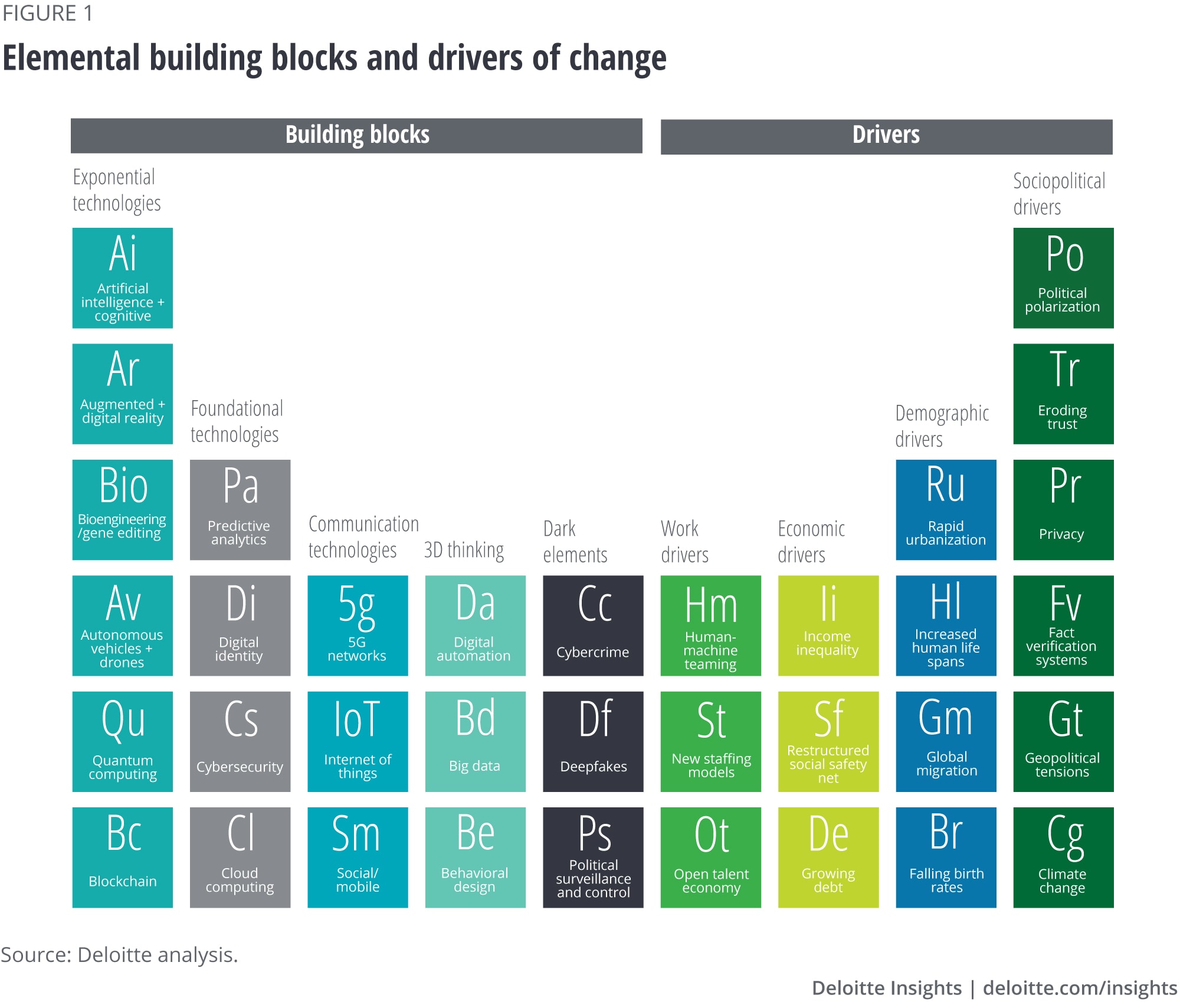
What really distinguishes today’s innovations is their synergistic power. Considered on their own, technologies such as the internet, 5G, and the ability to analyze big data are powerful engines of change. But they don’t operate independently. These technologies are often being used in powerful combination with each other, and the result is more like 1 + 1 + 1 = 111. Consider:
Wearable health monitor + predictive analytics + nudge thinking = precision medicine
Natural language processing + internet + machine learning = universal translation machine
Drone + facial recognition + laser targeting = surgical military strikes
Unlike inert matter, how these forces play out in government will depend on human choices. For example, facial recognition + AI + IoT cameras = 360 government awareness of citizens’ whereabouts. This could be used as a tool for law enforcement, or it could be limited due to privacy concerns or potential abuse, depending on citizen expectations, social preferences, and political dynamics. The danger: Without more rapid evolution in government, technology could get ahead of policy, increasing the risk that otherwise “good” technologies could be used in potentially harmful ways.
Government today: The impact of the great confluence
Inventions such as the printing press and the automobile made profound impacts but were relatively slow to proliferate. In the United States, the Ford Model T rolled into production in 1908. But the interstate highway system, which was needed to realize the automobile’s full potential, wasn’t signed into existence until 1956 and was only completed in 1992.
In contrast, the internet, and later the smartphone, transformed business, society, and government in less than 30 years (though that transformation is likely nowhere near complete). Tech advancements are bringing about social impacts at a rapid pace. As complementary factors are added, the impact is magnified due to the confluence of different elements—some technological, some not.
These examples illustrate the importance of confluence—the coming together of disparate streams to create something new. When synergistic tech innovation is combined with social forces and government actions, the impact can be shaped and amplified.
Technological confluence can foster organizational confluence: The case of the smart city
Technological confluence fosters organizational confluence. In other words, when technologies combine in new ways, the siloed, bureaucratic structures of the past require updating—in business or government. The synergy between new and newly connected technologies creates a multiplier effect. But it also creates the need to break boundaries, as the digital, connected universe of information forces together previously independent activities and organizational structures.
Take a smart city. In the past, any city public works department could operate reasonably effectively in an independent silo, repairing roads, clearing snow, maintaining streetlights, and so on. But in a hyperconnected city, data is collected and shared to optimize everything from traffic flows to garbage pickup to streetlights. This can, in effect, force various city departments to work more closely together, both from a technical and organizational perspective.
Now take it up a level. In order to maximize mobility, the city would work with the regional transit district, the airport authority, and private companies including ride-share, bike and scooter rentals, and more. To best serve citizens, establishing a unified, multimodal payment system makes sense. But it also requires breaking down technical and organization boundaries in a grand confluence of information and operations—a meeting of the virtual and physical worlds.
In the interplay between technological advancements and evolving social behaviors and trends, truly extraordinary breakthroughs are occurring.
These new hybrid technologies and behaviors are heavily interdependent, and this interdependence poses complications in executing and defining regulatory responsibilities. New innovations also often rely on vast swaths of data, including personal data. Yet governments today must grapple with oversight of these new applications from within mostly siloed organizations. Moreover, from health care to transportation to social services, nearly everything government does is becoming more data-driven—and now carries a greater risk for cyber mischief. This forces trade-offs between value creation and value protection to the front and center.
The incredible complexity of government can be seen in the multiplicity of agencies with myriad missions. How is it possible to contemplate the future of government if each agency is unique? The next section looks at that challenge and offers a way to look at similar government tasks that serve differing missions.
The five domains of government: A mission-agnostic view of future government
We tend to categorize government by the various missions reflected in its organizational structure.
Thus, the U.S. Department of State’s mission is to “lead America’s foreign policy through diplomacy, advocacy, and assistance …”1 Within the State Department, however, there are numerous bureaus, each with their own mission. For example, the Bureau of Arms Control, Verification and Compliance has a core mission suggested by its name. There are countless such “nested” missions in government, ranging from defense to social services.
This mission-oriented view is useful in organizing for execution; it helps coordinate the efforts of those dedicated to a particular goal, as well as for exploring the future of a particular agency. But it is not very helpful when contemplating the broader future of government. There are simply too many missions and too many varied activities in the public sector to paint a comprehensive picture of the future of government through that lens.
To help explore government’s future, we have identified five principal domains of government activity. These are:
- Service delivery
- Operations
- Policy and decision-making
- Talent/workforce
- Regulation and enforcement
We use the term “domains” for these areas to denote an area sharing a similar evolutionary path.
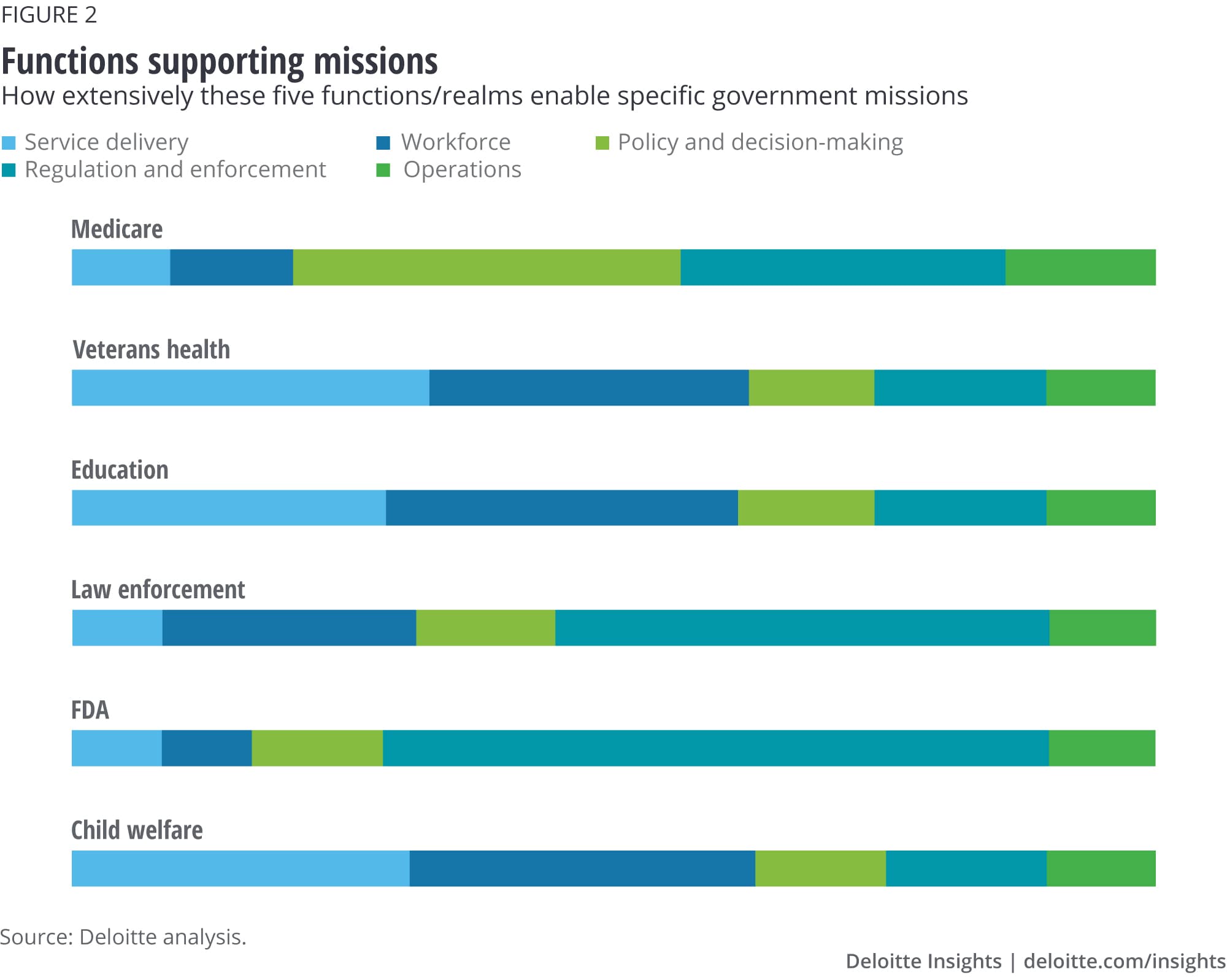
Virtually all government agencies are engaged in each of these domains, albeit in different proportions (figure 2). Even “regulatory” agencies are engaged in workforce and policymaking activities. And while police departments and the Army have heavy “enforcement” elements, they also have service delivery concerns. On the flip side, “enforcement” is not irrelevant for social service agencies or those issuing business licenses; they, too, have rules that must be followed.
The ubiquity of these domains across government makes them useful units of analysis to explore government futures. Using these domains as a guide, what follows is a vision for how the future of government could be optimally realized.
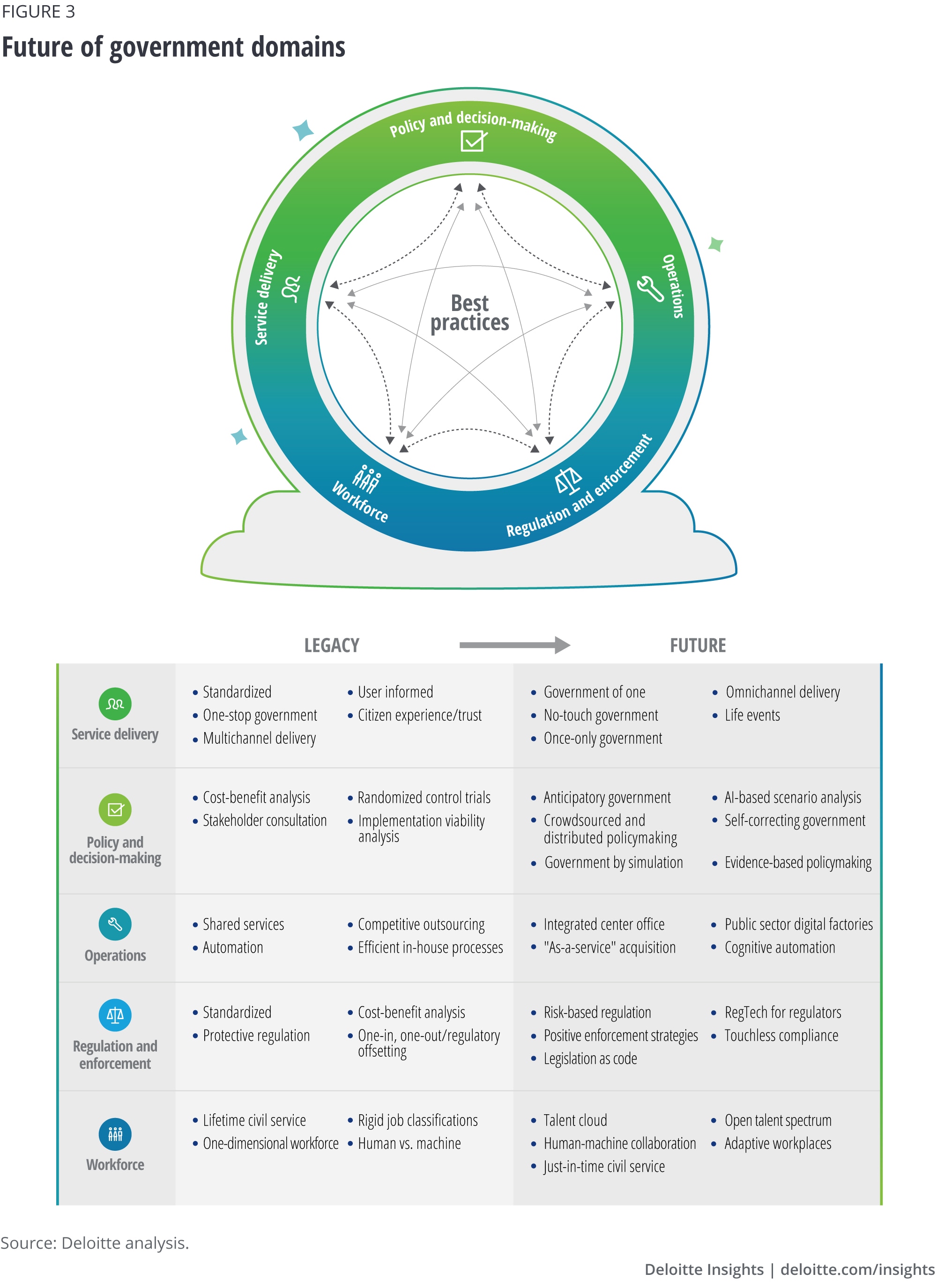
Service delivery
From Department of Motor Vehicles centers to court hearings, governments are transitioning to new methods of service delivery. Data-fueled services can offer citizens a truly personalized experience. 3D thinking—human-centered design, data, and digital—can come together to improve government interactions and make a personalized government of one experience a reality.
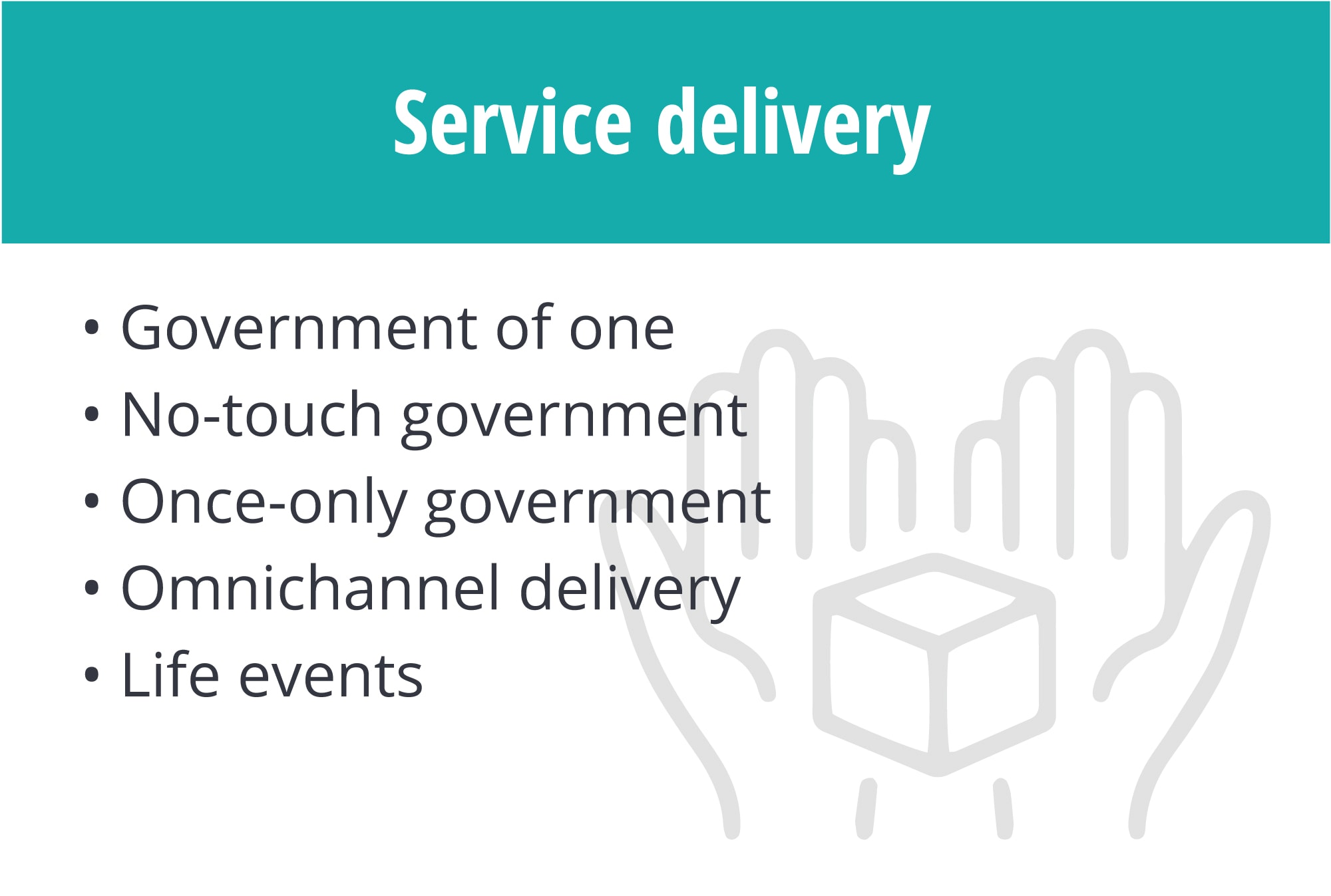
With no-touch government, services are provided digitally and automatically, without the need for citizens to initiate the transaction. When a child is born in Austria, citizens don’t have to complete a form or perform any other action to receive a family allowance. The birth triggers data transfers from the hospital to the central civil registry to the ministry of finance to local tax offices, which disburse the allowance.2 Many governments are adopting this idea of “once-only government,” in which all citizen-government interactions—applying for unemployment, renewing health insurance, or registering for retraining programs—can be conducted using a single digital identity.3 Interactions can take place anytime and anywhere, helping governments embrace an omnichannel future.
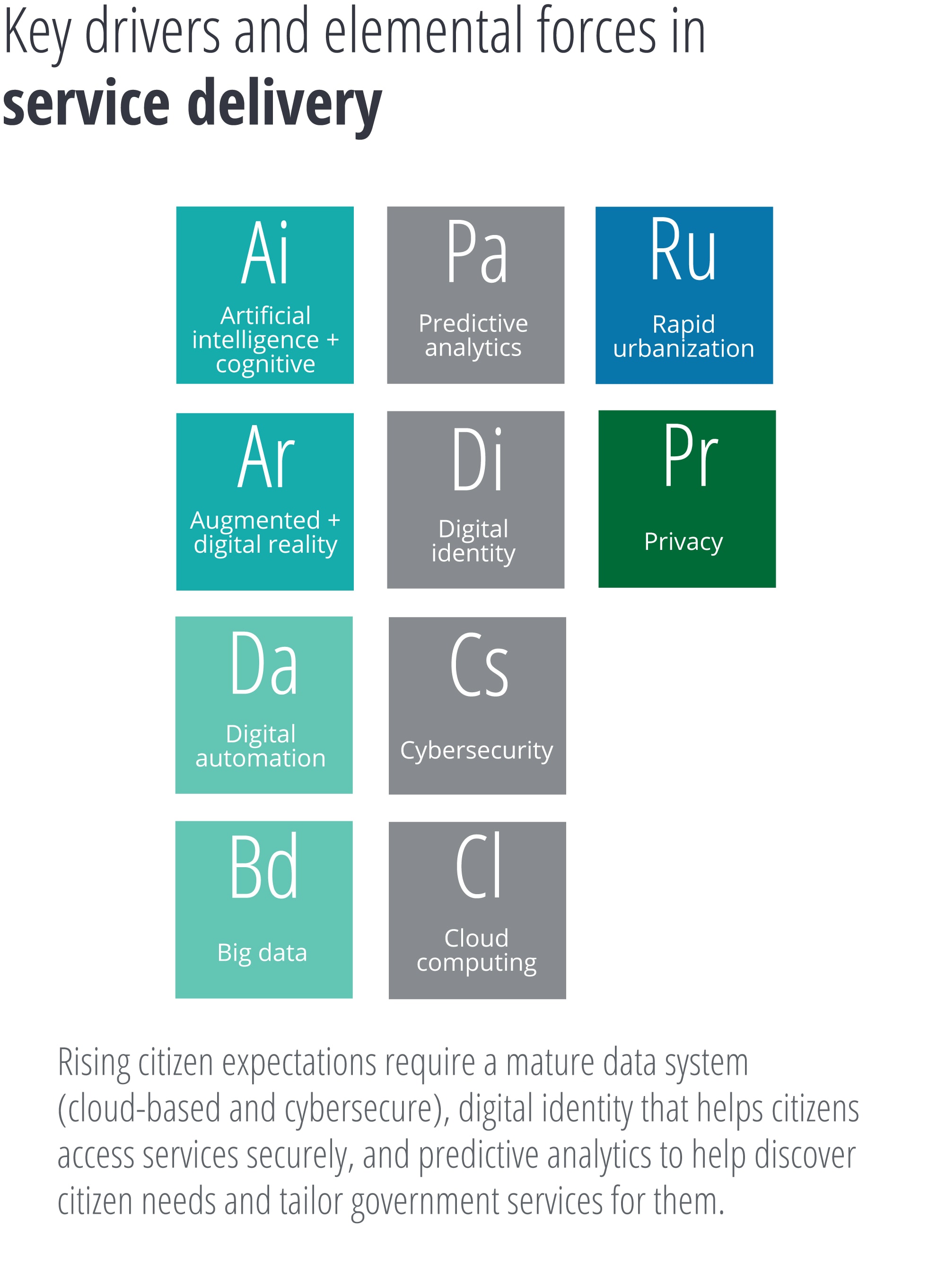
Increasingly, governments from Australia to Finland are also tailoring services to particular life events and user needs. Citizens and businesses no longer have to navigate an alphabet soup of agencies and regulators. Services are combined across local, state, and federal jurisdictions into simple, easy-to-use functions. Life events such as the birth of a child, name changes, the passing of a relative, an accident, or job loss typically require public services across the three tiers of government. With a life events focus, these events and their ensuing paperwork can be curated into a single “service-on-a-page,” sparing citizens and businesses the complexity of having to navigate government agencies.
Take probate services: a reformed system that creates a single, digital marketplace for end-of-life services (e.g., funerals, cemetery costs, insurance, superannuation, and estate savings). Establishing this type of system could save families tens of thousands of dollars.
Operations
The combination of AI, automation, cloud, and cybersecurity enables government agencies to make massive advances in efficiency and speed in operations. Following the lead of their commercial counterparts, governments can begin to integrate back-office functions such as HR, finance, and procurement—first digitally and then organizationally—under one umbrella. The result: an integrated center office that eliminates redundancies and reorients resources, such as people and budgets, in a more strategic manner.4 The traditional back office evolves from a mere transaction processor to an insight generator that leverages cross-functional data and talent to become a catalyst for enterprise transformation. Using this approach, a global pharmaceutical company delivered a 10X return on its investment in digitally-enabled solutions.5
Through “as-a-service” acquisition, services can be procured using a pay-as-you-go model, allowing agencies to scale services to match needs. As technology lowers the friction of purchasing, it becomes less important to have tasks performed in-house. As with cloud, as-a-service models make it easier to scale up or down with varying demand and can offer better cost per use. In the United States, for example, federal agencies can buy cloud services through this pay-as-you-go approach.6
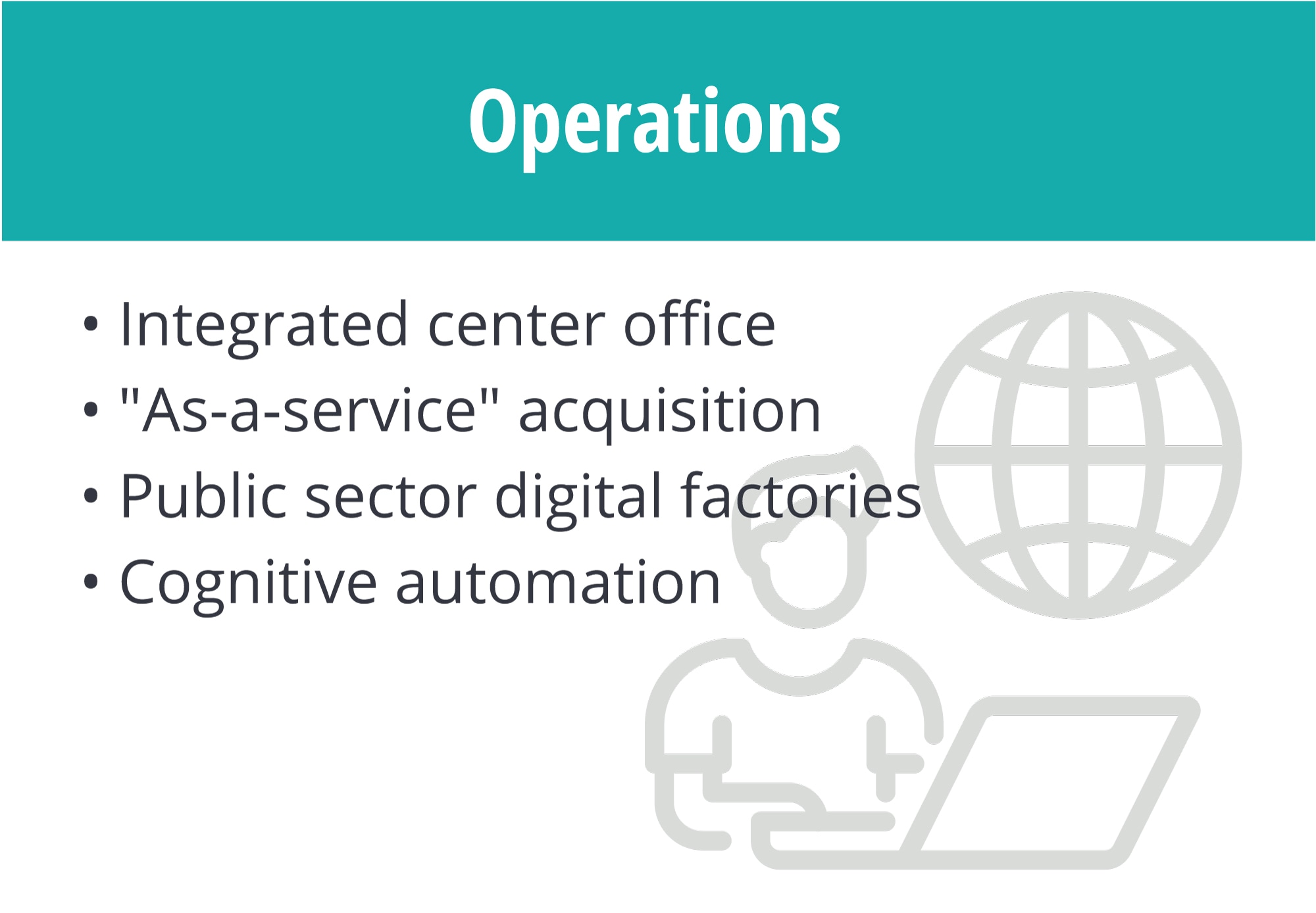
To achieve digital transformation, governments are setting up digital factories—cross-functional teams that operate outside the traditional rules of the organization and work in an agile manner. Instead of asking an existing organization to digitize itself, this concentrated digital expertise can combine with subject matter expertise to bring the benefits of digital to existing operations.
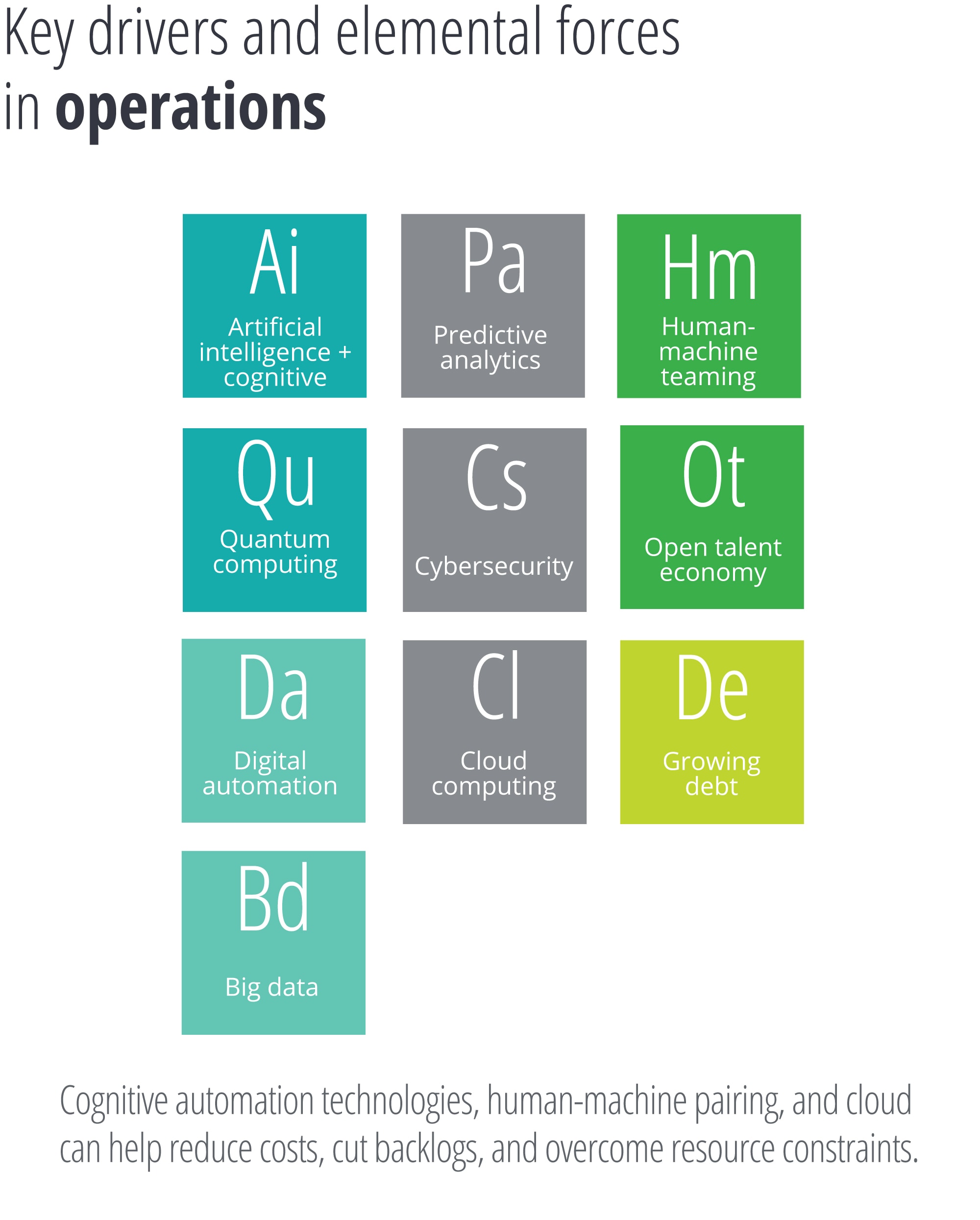
Cognitive automation mimics human behavior. Powered by advanced technologies such as natural language processing, text analytics, and data mining, cognitive automation enables governments to reduce costs, cut backlogs, and overcome resource constraints. The US Veteran Benefits Administration (VBA) tapped into the power of AI-enabled systems to quickly sort claims from multiple channels—mail, fax, and electronic submissions. This allowed the VBA to slash the time it spent sorting claims from 10 days to just four hours.7
Policy and decision-making
Policy development can become more responsive and agile by using rapid iteration and scaling to meet shifting needs and demands. Government agencies can use small prototypes and pilots, sandbox exercises, and staged rollouts to learn lessons, make changes, and avoid larger failures down the road.
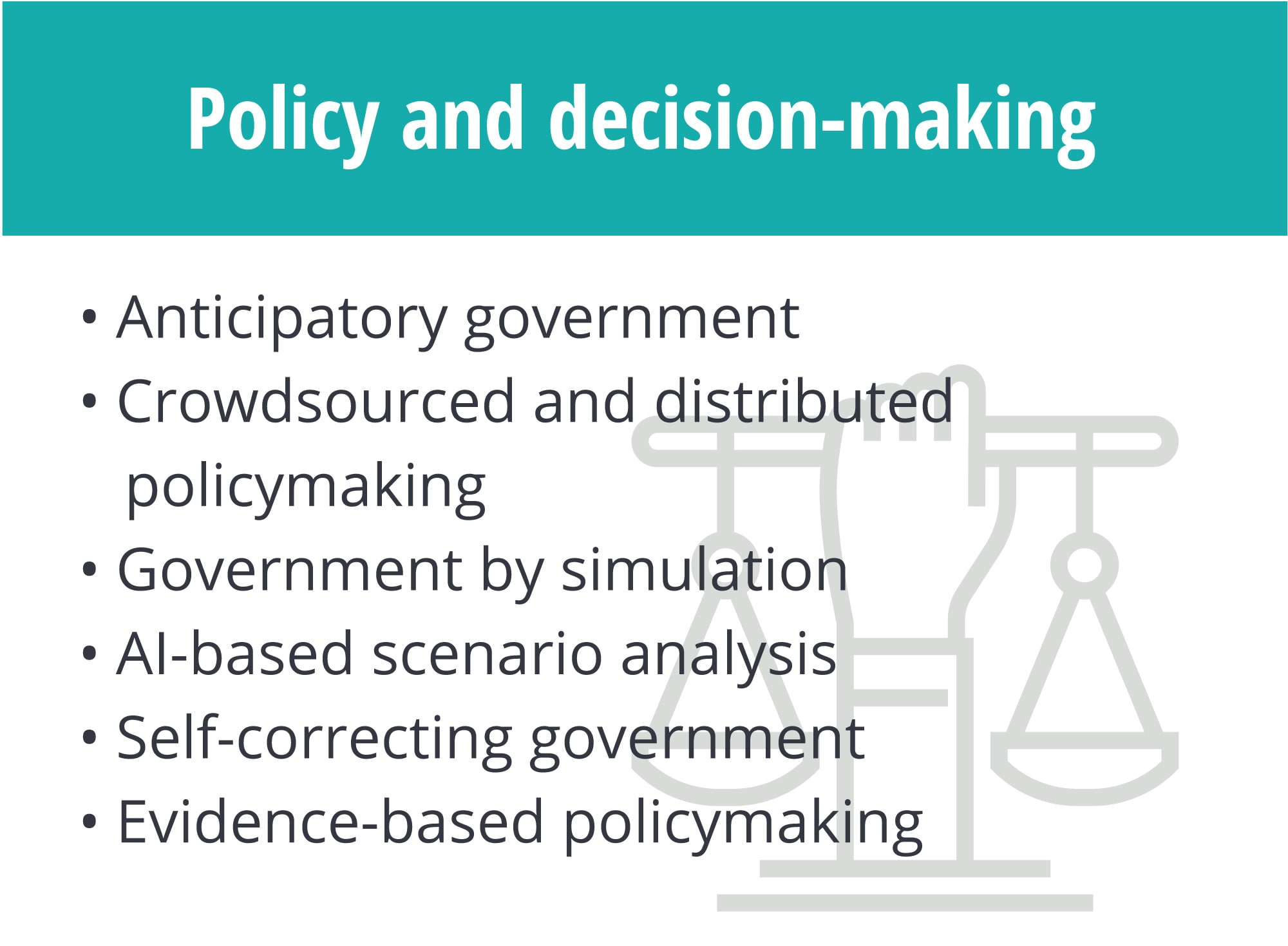
Anticipatory government, powered by AI and analytics, enables governments to not only predict undesirable activities but also prevent them from occurring. From spotting fraud to combatting the opioid epidemic, an ounce of prevention really is worth a pound of cure—especially in government. Predictive analytics is now being applied to a wide range of areas, from defense to human services.8
The pandemic has accelerated crowdsourced and distributed policymaking efforts across multiple areas. Recent examples include scientists collaborating with citizens to design virus-fighting proteins, and DIY communities designing open-source testing kits together.9
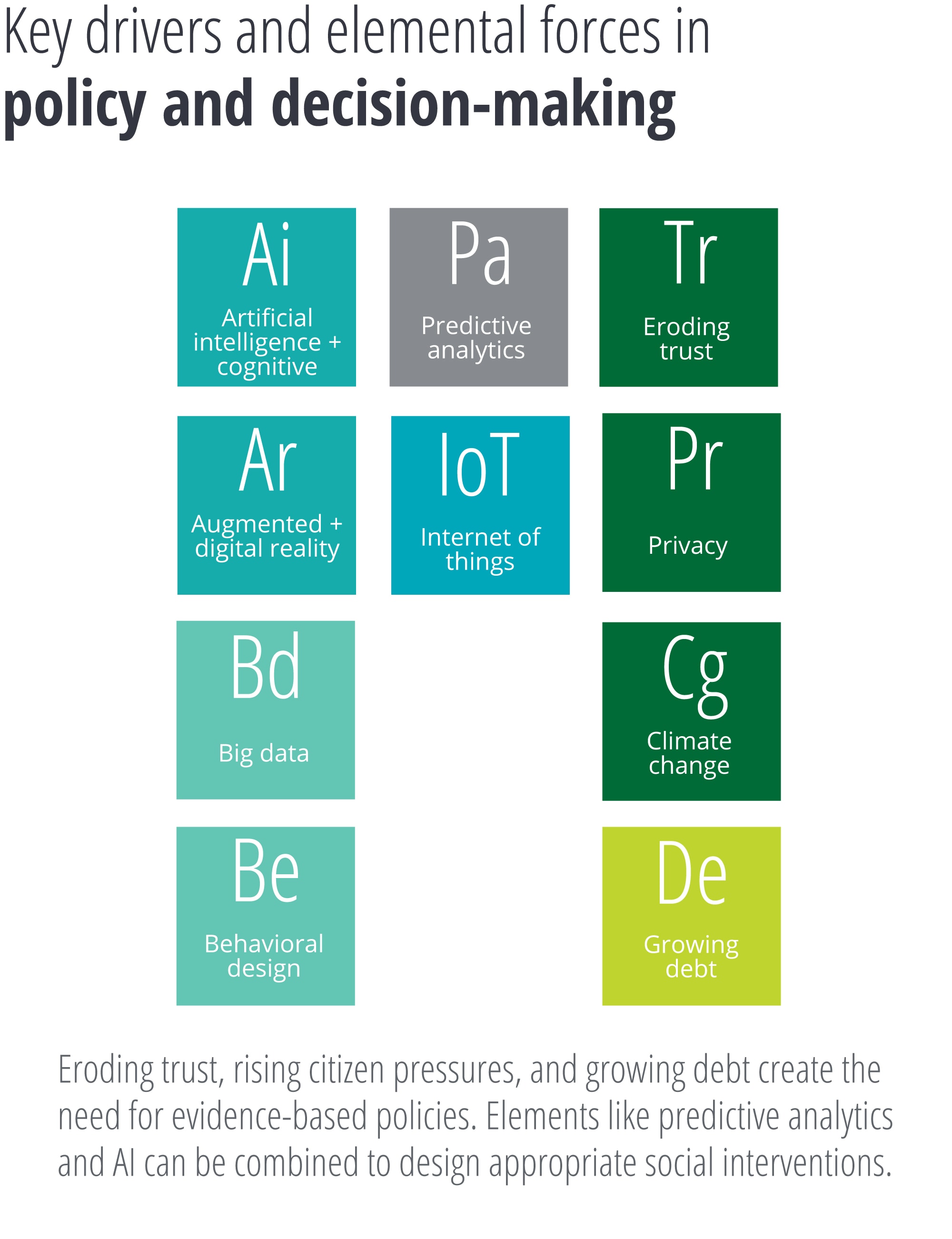
AI and digital twin technologies enable governments to test policies and options in real-life scenarios before adopting them. Such government by simulation can help improve decision-making in areas from city planning to disaster management. In February 2020, the New South Wales government in Australia launched a Spatial Digital Twin to transform urban planning and infrastructure.10
Machine learning technologies can help governments find the best solutions by providing a set of alternatives to accelerate decision-making. In the initial days of the COVID-19 pandemic, governments used AI-based scenario analysis to understand the causal linkages of different drivers and develop contingent plans of action.11 The unprecedented data-sharing and analytics can empower governments to build a collective “memory”—the ability to understand and learn from past failures and successes and, ultimately, become self-correcting.
Given the proliferation of data and the growing use of analytics, along with public pressure for results, evidence-based policymaking will continue to accelerate and mature. Australia, Canada, Colombia, Finland, the United Arab Emirates, and hundreds of cities across the world have set up units to use evidence to evaluate the impact of public programs.12 The Canadian Treasury Board has directed agencies to spend a fixed percentage of their budgets to experiment with new approaches for policy design and delivery, measuring impact to understand what works and what does not.13
Workforce
As work is transformed, so too is the workforce. AI, automation, and other emerging technologies will soon become ubiquitous, helping people work smarter wherever they are. By collaborating with intelligent machines, government employees can use additional tools and resources to learn and reskill as their work evolves.
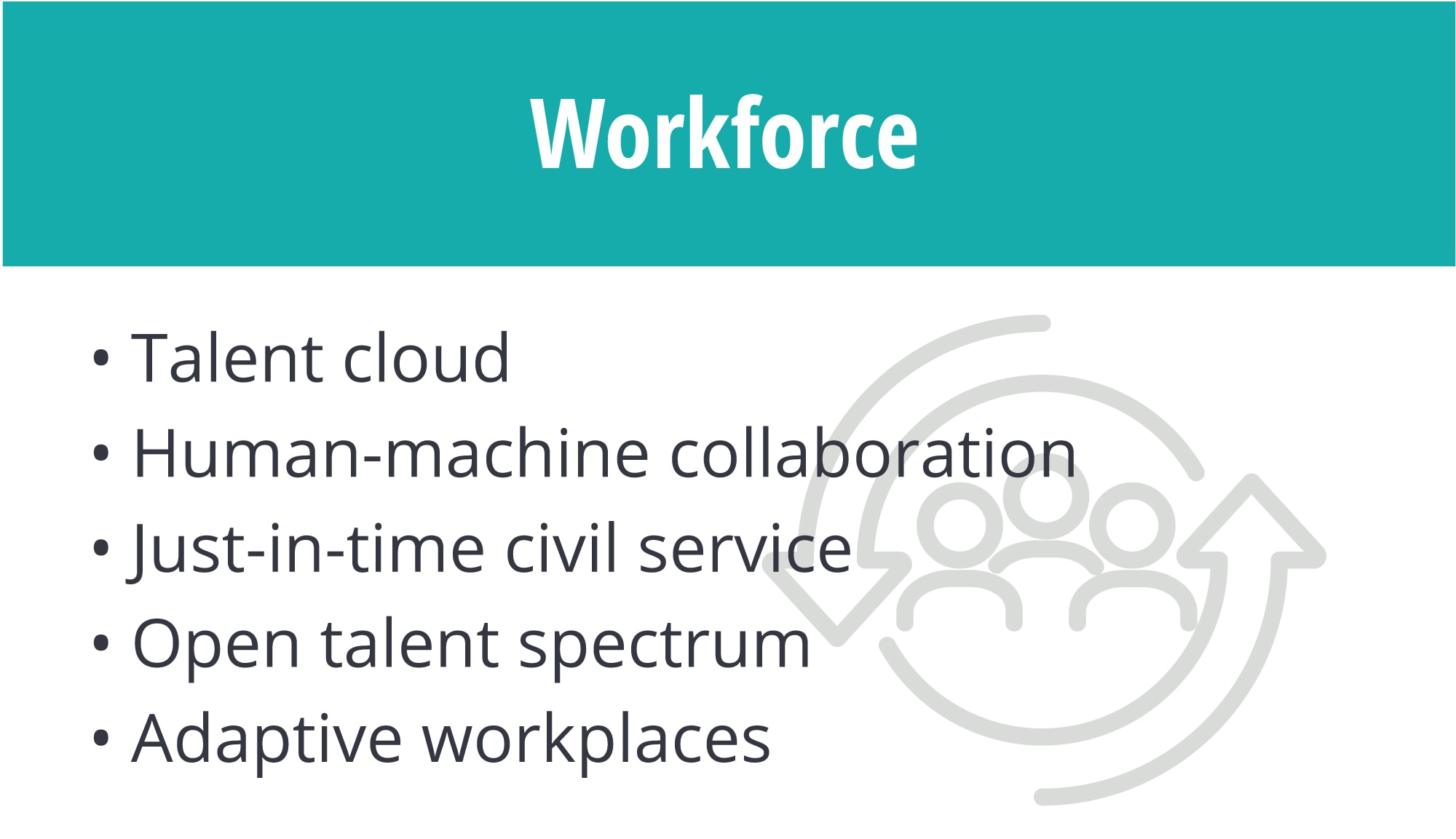
Today, much of the world’s IT infrastructure lives in the cloud, which allows users to access and pay for exactly the resources they need, when they need them. Access to talent can follow a similar, on-demand talent cloud model. The Government of Canada (GC), and in the United States, NASA, the EPA, the military, and other governments have all launched talent marketplaces in recent years. Agencies that need people with specific capabilities can search the marketplace and quickly find people to fill roles on projects of finite duration. Workers retain rights, benefits, and union representation.14
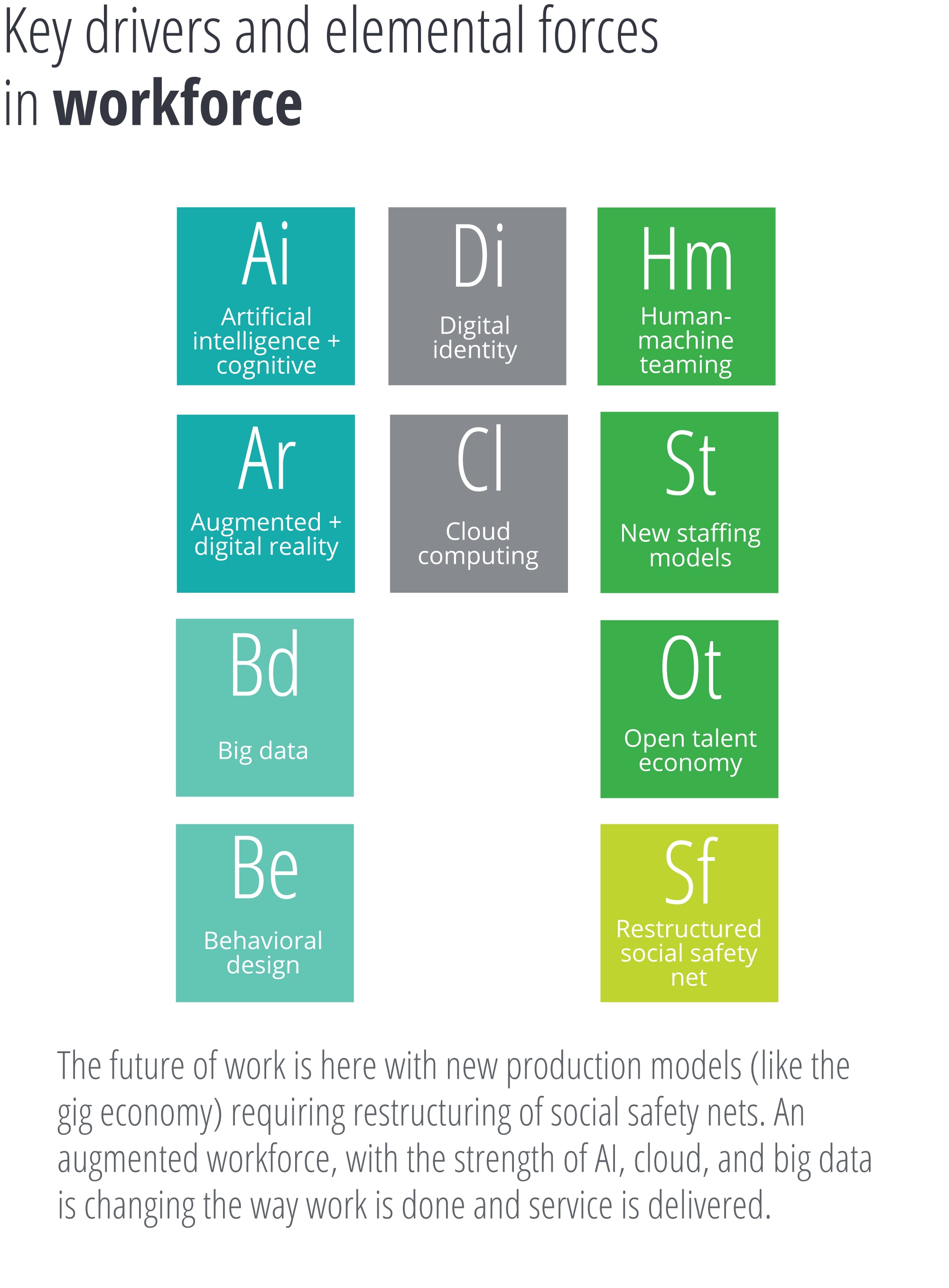
There are many ways in which humans and machines can work together. Machines can work for us, with us, and can sometimes even help guide us. Human + machine collaboration can optimize results and, by playing to each entity’s innate strengths, create approaches superior to those that either humans or machines could create on their own. An AI-enabled chatbot could work together with a human services caseworker, for example, to provide services to a client in need. As the employee engages with the client on the phone, the AI system could transcribe the conversation, automatically flagging relevant information as it comes up. This would allow the employee to focus on the conversation and contextual clues, while the AI suggests tactical solutions.
Governments could move from a lifetime civil service model—in which many employees spend a decades-long career at a single agency—to just-in-time civil service. In this model, talent is nimble, flexible and can come from a variety of sources—not just from within government—depending on the needs of a project. Such an open talent spectrum could include partnership talent (employees who are part of joint ventures), borrowed talent (employees of contractors), freelance talent (independent, individual contractors), and open-source talent (people who don’t work for government at all, but are part of a value chain of services). This shift from a closed model to a more inclusive open one would redefine the “public workforce.” It would require rethinking everything from hiring to retirement, including compensation.
The future of government will also require redefining post–COVID-19 workplaces to become adaptive workplaces: People and teams will work where they are most productive and engaged, depending on the task. In such a hybrid setup, governments benefit from access to greater talent pools since location is no longer a constraint. However, systems and processes designed for a purely in-office model will need to be redesigned.
Regulation and enforcement
Regulatory agencies are increasingly collaborating with businesses to protect the public in ways that can stimulate economic growth and foster innovation. This entails creating agile, risk-based regulations and enforcement mechanisms that can quickly adapt to changing circumstances. Ensuring that rules are transparent and easy to navigate can encourage innovation and protect the public from unintended consequences.
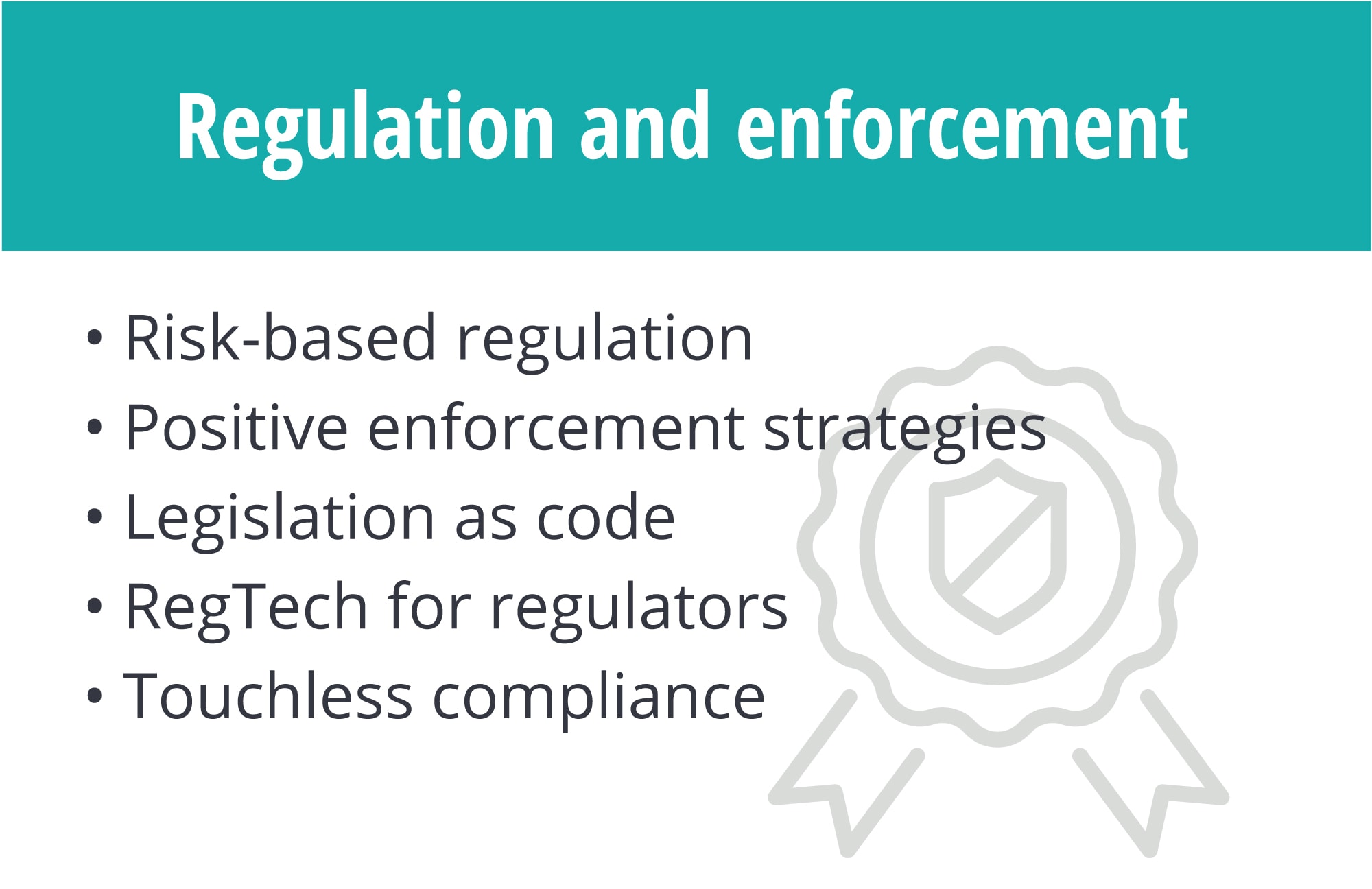
Risk-based regulation (RBR) identifies activities and firms that pose a high risk to consumer safety and minimizes the burden for low-risk firms. To categorize firms into a specific risk category, regulators can analyze a host of data, such as compliance history, consumer feedback, information from other regulators, and other open data.15 The Irish Food Safety Authority links the frequency of inspections to risk category and a firm’s risk category can move up or down based on its compliance history.16 In the future, RBR could become the norm rather than the exception.
Positive enforcement strategies that reward good behavior can encourage people to focus on meeting and exceeding regulatory requirements rather than doing the bare minimum to simply avoid penalties. Surveys found that guidelines that include positive enforcement prompt companies to set up and add vigor to their internal compliance systems.17
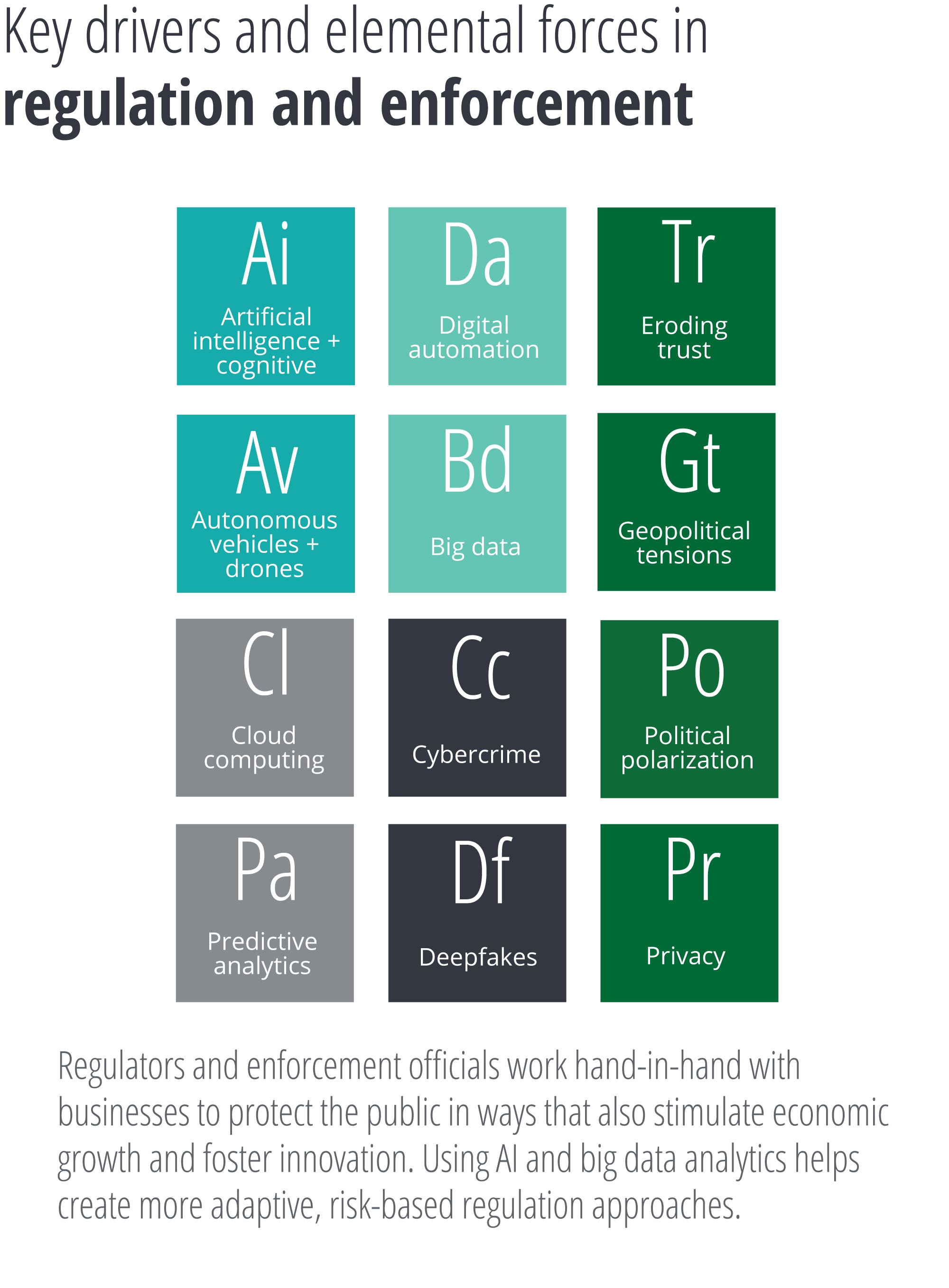
Current legislation is interpreted by humans—mostly lawyers and policy analysts. But following New Zealand’s pathbreaking approach, future governments can convert legislation into software code. When legislation is updated, machines automatically make updates, reducing the need to hire experts that understand the impact of updated legislation. Another significant advantage of machine-readable laws is the opportunity to test policies in various scenarios (think of digital twins), similar to how technology companies test software code.18
For regulators, RegTech technologies offer new opportunities to fundamentally reinvent rulemaking, oversight, inspections, and enforcement. They can help regulators automate “grunt work” and make better, faster decisions.19 Regulators are also better equipped to anticipate and sense problems.
Technology has also aided in the journey toward touchless compliance. No more handing over documents in line at the airport or getting pulled over on the highway. Travel documents can be scanned electronically; speed can be captured digitally—verified from your smart car telemetry—with a bill for speeding sent to your account.
Getting from here to there? The five big paradigm shifts
In general, governmental change tends to be slow, with most improvements incorporated incrementally over time. But periodically, more transformational changes occur. A time traveler who died in the 1950s would feel largely at home in a modern library but may barely recognize certain aspects of the military. From drone airstrikes and sophisticated cyber intelligence efforts to women in combat roles and the lack of a draft, both the tools of the trade and those who wield them have changed significantly. Even the concept of the “enemy” has broadened from the clarity of nation-states at war over boundaries to clashes with loosely organized terrorist organizations controlling ill-defined regions. While the uniforms look the same and sergeants still yell at recruits, much about the military has been transformed from 70 years ago.
How can other government entities achieve similar levels of transformation? How can an institution designed to limit change transform to deal with today’s pace of change?
History shows it won’t be easy. It will likely require a fundamental shift in mindset from both political leaders and public service professionals. These five major paradigm shifts will be critical to making the changes outlined in the previous section, a reality:
Adaptive: Evolve as quickly as the economy
Governments will need to shift gears and adopt approaches that are more proactive, fluid, and responsive to change. The goal should be continuous reinvention, the emergence of new business models, and radical innovation.
“[G]overnance can be, and some would argue should be, more agile to keep pace with the rapid changes of society—driven significantly by the rapid development and deployment of emerging technologies. Policymakers must become more proactive in shaping these developments.”20—The World Economic Forum
Two-gear: Get today’s job done and innovate for the future
Governments will need to divide their resources, balancing operational optimization with innovative experimentation—redesigning the airplane while it is in flight, so to speak.
“I’ve always felt our strong regulatory regime has been a significant positive for our efforts to grow and develop the financial sector. Most of the time, it’s not a trade-off. It is how the two—regulation and promotion—work in concert to create an environment that promotes innovation while ensuring safety and public confidence.”21—Ravi Menon, managing director, Monetary Authority of Singapore
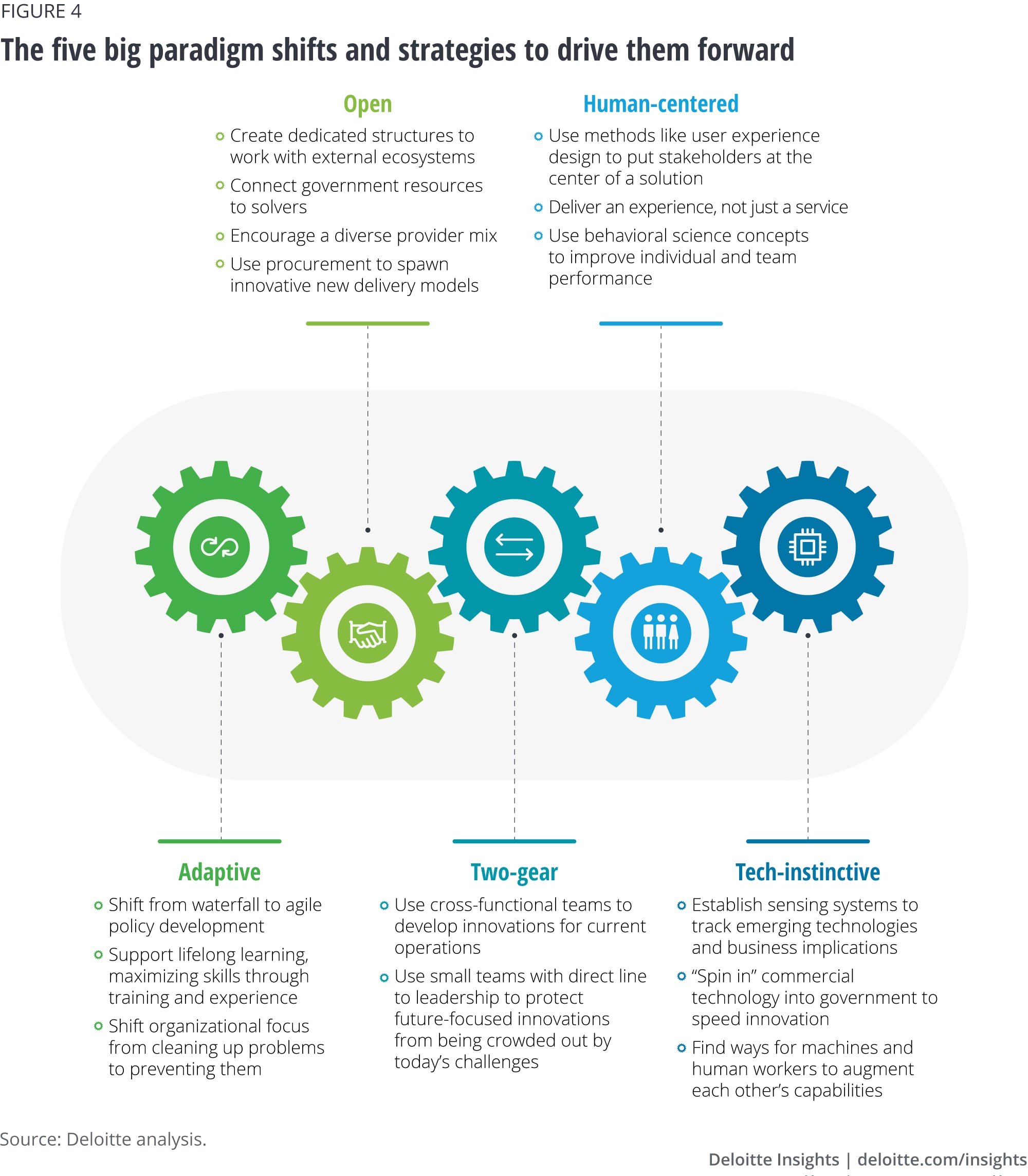
Tech-instinctive: Don’t dabble in digital—become deeply digital
Technology will be one of the biggest drivers of future government. As such, governments will need to move from a state of passive tech adoption to being tech-instinctive. This happens when technological change is a core part of a government’s DNA—deeply connected with how it operates and delivers services.
“The e-government cabinet, e-health services, online voting, online pre-filled tax returns, e-mobile parking, are all examples of Estonian innovation, but far more importantly, they are examples of the transformative power of intensive and extensive use of information technology in the public sector.”—Toomas Hendrik Ilves, former President of Estonia
Human-centered: Put people first—in everything
Technology is only one important part of transforming government but it likely won’t be sufficient. The government of the future will also need to be more human-centered. From employees to citizens and constituents, government organizations should put people at the heart of everything they do.
“Developing services based on people’s key life events allows governments to deliver the highest impact support to people when they need it the most. Research tells us that designing services around life events aligns with how people think about interacting with government.”22—Lucy Poole, head of Government Digital Experience, digital transformation agency, Australia
Open: Solve problems by tapping into external ecosystems
Transformational change requires governments to look beyond the walls of their organizations. They should be open, carving out new and innovative methods to collaborate with different partners for their mission needs. Building ecosystems that continuously seek solutions both internally and externally should become a core competency of future government.
“We find ourselves in a position where we no longer have to do everything within NASA. We don't have to do everything within our contracts or community now that we can see projects on the outside. The commercial space industry is able to provide us with capabilities that before we had to do on our own. We're able to leverage the technology and capability from other industries ...”23—Steven Gonzalez, technology transfer strategist, NASA Johnson Space Center
The challenge of adopting new paradigms
People don’t simply decide to embrace new paradigms. These fundamental changes take hold when the old paradigms no longer fit a new reality, or when clinging to an outdated paradigm produces unacceptable results. Only then will public perception adapt to the forces coming together in our rapidly advancing future demanding change.
There is evidence that these new paradigms are starting to take hold in the emerging trends that can be observed in government today.24 These new paradigms can serve as high-level guides on how policies, organizations, and behaviors should change. But make no mistake: Making these shifts the norm, not the exception, will be a massive challenge, culturally and institutionally. Nevertheless, COVID-19 has demonstrated that government can change—and change very quickly—when necessary.
The journey has begun
As we look ahead, consider where exactly government stands today.
On the one hand, we see governments using the latest technology to do things that were previously impossible.25 Today, any small-town sheriff can install a few cameras and use automated license plate recognition to identify thousands of plates per minute and cross-check against outstanding arrest warrants. If there is a match, local patrol cars are given the location, plate, and vehicle information—and the blue lights start flashing. This sort of technology can seem like magic: It has made what was impossible only a few years ago commonplace.
On the other hand, we see governments struggling to execute seemingly routine operational functions. When California Governor Gavin Newsom took office in January 2019, he set a simple goal for the state’s Department of Motor Vehicles: To accept credit cards at DMV offices.26 The technology has been possible for decades, but the driving force to serve a captive market had been lacking. Today, fortunately, the California DMV accepts credit cards. Too often, basic government services deliver a disappointing customer experience.
This uneven performance is proof that the future doesn’t arrive all at once—nor should we expect it to. Government is not a high-tech startup; the public sector has to balance its journey into the digital future with ongoing daily responsibilities. And unlike a private company, government can’t choose to serve only those willing to avail themselves of the latest technology. It has to serve all comers, while also choosing what to invest in for the future.
Government’s journey into the future starts with disrupting the legacy systems and organizational silos based on past circumstances. Often, these silos are rooted in legislation.
Can an institution designed in an era of incremental change succeed in an era of transformation? We must work together to make the answer “Yes!”
© 2021. See Terms of Use for more information.
More from the Government & public services collection
-
Planning a new presidential term amid growing uncertainties Article4 years ago
-
The revenue agency of the future Article5 years ago
-
AI-augmented government Article5 years ago
-
The digital citizen Article5 years ago
-
The future of intelligence analysis Article5 years ago
-
Convergence of technology in government Article5 years ago














